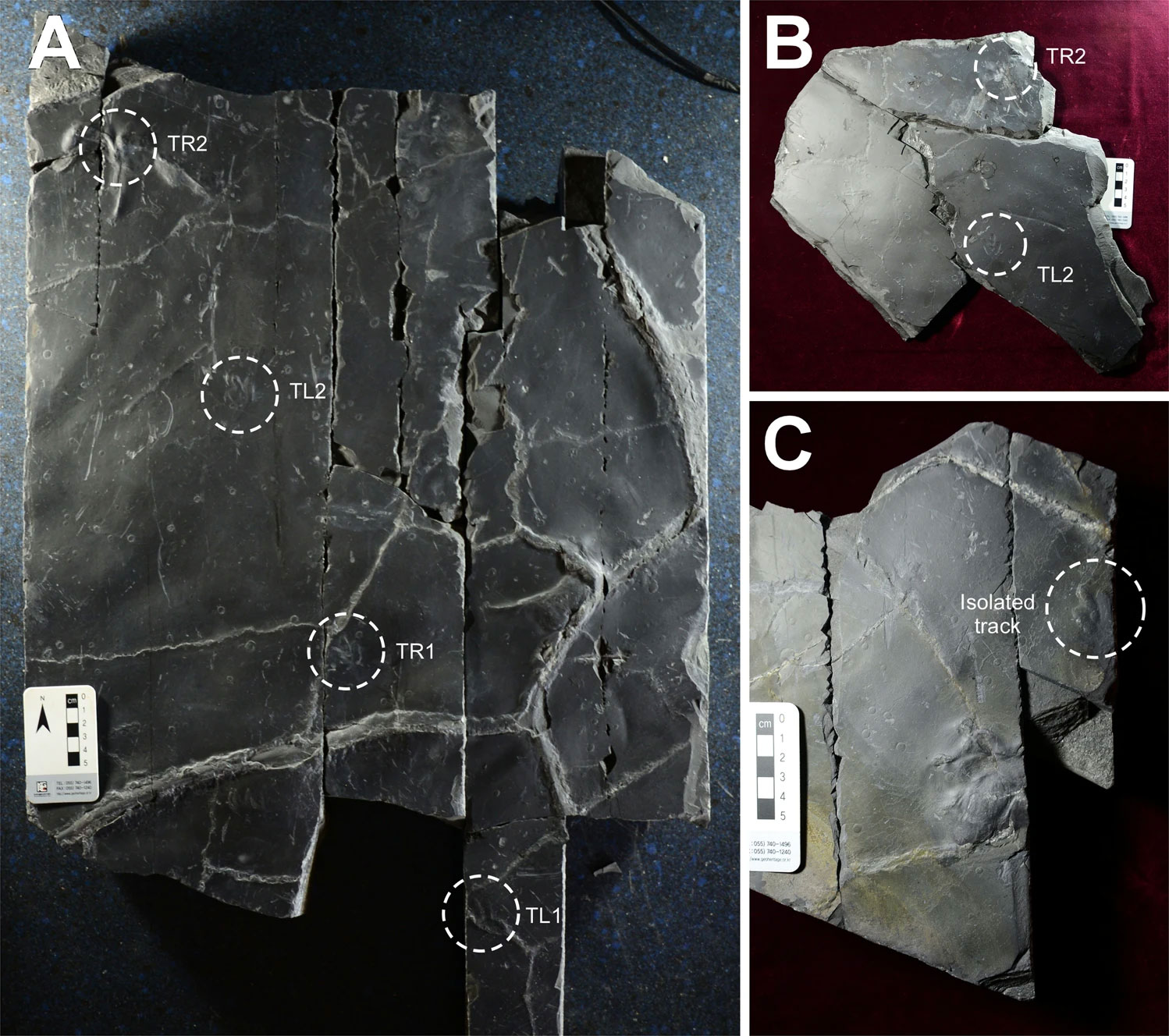High-definition dinosaur skin traces left during a rain shower
Have you ever seen a dinosaur running in the rain? A stunning find of fossil trackways near Jinju City, Korea, is the closest thing so far that anyone alive today has got to such a scenario, other than watching it on a screen. A team of researchers have discovered what they’re calling small theropod dinosaur tracks, together with exquisitely preserved skin traces. They have given them the ichnogenus1 name Minisauripus.2,3 “These are the first tracks ever found where perfect skin impressions cover the entire surface of every track,” said paper author Professor Emeritus of Geology Martin Lockley.4 The paper stated that, “Such consistent ‘coverage’ is unprecedented for any known dinosaur track occurrences”.

Running in the rain?
The trace fossil footprints are made up of a sequence of four tracks, and one lone footprint. They are only an inch (2.5 cm) long and were made on a very thin layer of fine mud. The scientists calculated how fast the dinosaur was travelling by measuring how far apart the footprints were in relation to the size that Minisauripus is thought to be. Motoring along at around 9 km/h the purported dinosaur was progressing swiftly as it moved across the mud, which is one of the reasons it was able to leave such a clear footprint. If it had been going slowly, or standing in the same spot for any length of time the contact with the fine mud would have left a less detailed print. Each print resulted from a quick dab of the foot in the mud, with just enough impact to leave a perfect replica of the scaly foot—and in so doing, demonstrating a history of motion.
The research team also discovered water-drop impressions surrounding the footprints. This provided evidence that the tracks were made during or just after a rain shower, with one of the water-drop impressions actually being stepped on by the dinosaur.
Everything about this astonishing find speaks of rapid processes. There is no scenario in which a slow sedimentation process could have preserved these trace fossils, as a lengthy period of time would have seen the delicate footprints and raindrops eroded away. By default this also means that the rock layer within which they are contained was also formed quickly.

Verifying biblical history
While the authors of the paper claim that these amazingly detailed footprints were left behind during the ‘Cretaceous’ period (120–112 million years ago) it makes more sense to associate them with the first 150 days of the Noahic Flood (around 4,500 years ago), when the land was being progressively inundated. The observation of the trace fossils fits the BEDS (Briefly Exposed Diluvial Sediments) model.5 During this chaotic time there were briefly exposed layers of sediment, newly created by the surging flood waters as water levels fluctuated up and down. With a new layer temporarily exposed, creatures like the dinosaurs were briefly able to walk on it, and the rain drops strike it, before the water level rose again. As it did so, more muddy sediment quickly covered trackways and raindrop impressions, thereby enabling their preservation.
Those dinosaurs outside of Noah’s Ark would ultimately have perished, whereas those on board would have survived and lived with humans after the Flood. Such finds fit very well with the biblical history, but only serve to confuse those who wish to “deliberately overlook…. the world that then existed was deluged with water and perished” (2 Peter 3:5–6).
References and notes
- An ichnogenus is a classification based solely on fossil traces such as tracks or burrows where these are deemed to be distinctive and not from a type known from other evidence. Return to text.
- Kim, K., Lockley, M.G., Lim, J.D. & Xingand, L., Exquisitely-preserved, high-definition skin traces in diminutive theropod tracks from the Cretaceous of Korea, Scientific Reports 9, 2039, 2019 | doi:10.1038/s41598-019-38633-4. Return to text.
- There have been other scientific reports of fossil trackways assigned to Minisauripus—this new report is of what are considered to be the ‘oldest’ tracks so far found. Tracks from eight other localities in China and Korea are already known. It is of course their preserved skin impressions that are especially noteworthy. Return to text.
- University of Colorado Denver, Perfectly preserved dinosaur skin found in Korea, phys.org, 9 April 2019. Return to text.
- Oard, M.J., Dinosaur Challenges and Mysteries: How the Genesis Flood Makes Sense of Dinosaur Evidence—Including Tracks, Nests, Eggs, and Scavenged Bonebeds, Creation Book Publishers, Powder Springs, GA, chapter 8, 2011. Return to text.








Readers’ comments
Comments are automatically closed 14 days after publication.